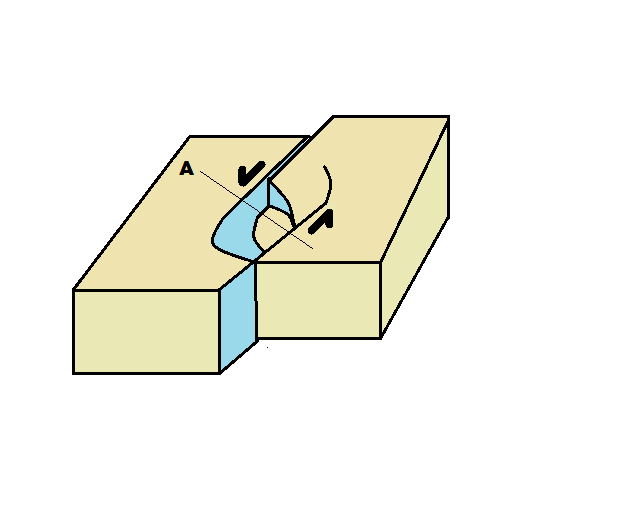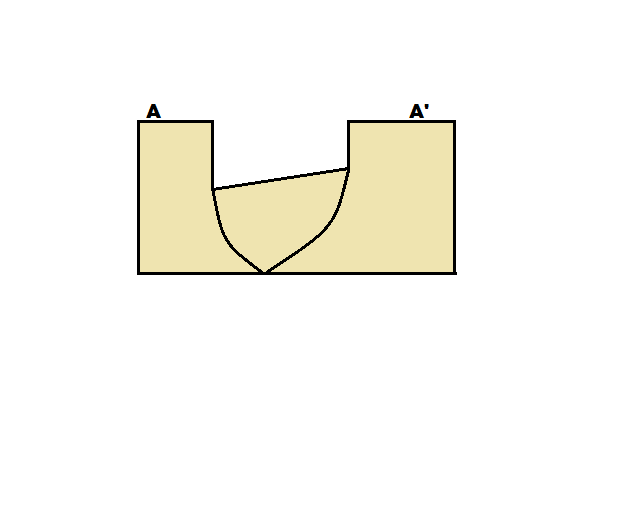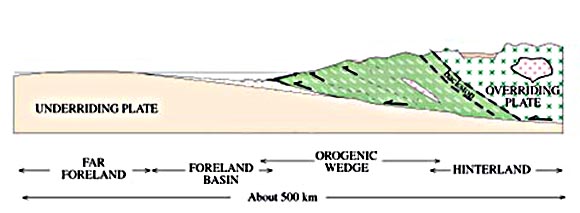Intracontinental basin on:
[Wikipedia]
[Google]
[Amazon]
Tectonic subsidence is the sinking of the Earth's crust on a large scale, relative to crustal-scale features or the
 Where the lithosphere undergoes horizontal extension at a normal fault or rifting center, the crust will stretch until faulting occurs, either by a system of normal faults (which creates horsts and grabens) or by a system of listric faults. These fault systems allow the region to stretch, while also decreasing its thickness. A thinner crust subsides relative to thicker, undeformed crust.
Where the lithosphere undergoes horizontal extension at a normal fault or rifting center, the crust will stretch until faulting occurs, either by a system of normal faults (which creates horsts and grabens) or by a system of listric faults. These fault systems allow the region to stretch, while also decreasing its thickness. A thinner crust subsides relative to thicker, undeformed crust.
 Lithospheric stretching/thinning during rifting results in regional necking of the lithosphere (the elevation of the upper surface decreases while the lower boundary rises). The underlying asthenosphere passively rises to replace the thinned mantle lithosphere. Subsequently, after the rifting/stretching period ends, this shallow asthenosphere gradually cools back into mantle lithosphere over a period of many tens of millions of years. Because mantle lithosphere is denser than asthenospheric mantle, this cooling causes subsidence. This gradual subsidence due to cooling is known as "thermal subsidence".
Lithospheric stretching/thinning during rifting results in regional necking of the lithosphere (the elevation of the upper surface decreases while the lower boundary rises). The underlying asthenosphere passively rises to replace the thinned mantle lithosphere. Subsequently, after the rifting/stretching period ends, this shallow asthenosphere gradually cools back into mantle lithosphere over a period of many tens of millions of years. Because mantle lithosphere is denser than asthenospheric mantle, this cooling causes subsidence. This gradual subsidence due to cooling is known as "thermal subsidence".


 Intracontinental basins are large areal depressions that are tectonically inactive and not near any plate boundaries. Multiple hypotheses have been introduced to explain this slow, long-lived subsidence: long-term cooling since the breakup of
Intracontinental basins are large areal depressions that are tectonically inactive and not near any plate boundaries. Multiple hypotheses have been introduced to explain this slow, long-lived subsidence: long-term cooling since the breakup of
 Forearc basins form in subduction zones as sedimentary material is scraped off the subducting oceanic plate, forming an accretionary prism between the subducting oceanic lithosphere and the overriding continental plate. Between this wedge and the associated
Forearc basins form in subduction zones as sedimentary material is scraped off the subducting oceanic plate, forming an accretionary prism between the subducting oceanic lithosphere and the overriding continental plate. Between this wedge and the associated
 Foreland basins are flexural depressions created by large fold thrust sheets that form toward the undeformed continental crust. They form as an isostatic response to an orogenic load. Basin growth is controlled by load migration and corresponding sedimentation rates. The broader a basin is, the greater the subsidence is in magnitude. Subsidence is increased in the adjacent basin as the load migrates further into the foreland, causing subsidence. Sediment eroded from the fold thrust is deposited in the basin, with thickening layers toward the thrust belt and thinning layers away from the thrust belt; this feature is called differential subsidence.
Foreland basins are flexural depressions created by large fold thrust sheets that form toward the undeformed continental crust. They form as an isostatic response to an orogenic load. Basin growth is controlled by load migration and corresponding sedimentation rates. The broader a basin is, the greater the subsidence is in magnitude. Subsidence is increased in the adjacent basin as the load migrates further into the foreland, causing subsidence. Sediment eroded from the fold thrust is deposited in the basin, with thickening layers toward the thrust belt and thinning layers away from the thrust belt; this feature is called differential subsidence.
geoid
The geoid () is the shape that the ocean surface would take under the influence of the gravity of Earth, including gravitational attraction and Earth's rotation, if other influences such as winds and tides were absent. This surface is extended ...
. The movement of crustal plates and accommodation spaces created by faulting
In geology, a fault is a planar fracture or discontinuity in a volume of rock across which there has been significant displacement as a result of rock-mass movements. Large faults within Earth's crust result from the action of plate tectonic ...
create subsidence on a large scale in a variety of environments, including passive margin
A passive margin is the transition between oceanic and continental lithosphere that is not an active plate margin. A passive margin forms by sedimentation above an ancient rift, now marked by transitional lithosphere. Continental rifting cre ...
s, aulacogen
An aulacogen is a failed arm of a triple junction. Aulacogens are a part of plate tectonics where oceanic and continental crust is continuously being created, destroyed, and rearranged on the Earth’s surface. Specifically, aulacogens are a ri ...
s, fore-arc basins, foreland basins, intercontinental basins and pull-apart basins. Three mechanisms are common in the tectonic environments in which subsidence occurs: extension, cooling and loading.
Mechanisms
Extension
Cooling
 Lithospheric stretching/thinning during rifting results in regional necking of the lithosphere (the elevation of the upper surface decreases while the lower boundary rises). The underlying asthenosphere passively rises to replace the thinned mantle lithosphere. Subsequently, after the rifting/stretching period ends, this shallow asthenosphere gradually cools back into mantle lithosphere over a period of many tens of millions of years. Because mantle lithosphere is denser than asthenospheric mantle, this cooling causes subsidence. This gradual subsidence due to cooling is known as "thermal subsidence".
Lithospheric stretching/thinning during rifting results in regional necking of the lithosphere (the elevation of the upper surface decreases while the lower boundary rises). The underlying asthenosphere passively rises to replace the thinned mantle lithosphere. Subsequently, after the rifting/stretching period ends, this shallow asthenosphere gradually cools back into mantle lithosphere over a period of many tens of millions of years. Because mantle lithosphere is denser than asthenospheric mantle, this cooling causes subsidence. This gradual subsidence due to cooling is known as "thermal subsidence".
Loading
The adding of weight bysedimentation
Sedimentation is the deposition of sediments. It takes place when particles in suspension settle out of the fluid in which they are entrained and come to rest against a barrier. This is due to their motion through the fluid in response to the ...
from erosion
Erosion is the action of surface processes (such as water flow or wind) that removes soil, rock, or dissolved material from one location on the Earth's crust, and then transports it to another location where it is deposited. Erosion is dis ...
or orogenic processes, or loading, causes crustal depression and subsidence. Sediments accumulate at the lowest elevation possible, in accommodation spaces. The rate and magnitude of sedimentation controls the rate at which subsidence occurs. By contrast, in orogenic
Orogeny is a mountain building process. An orogeny is an event that takes place at a convergent plate margin when plate motion compresses the margin. An ''orogenic belt'' or ''orogen'' develops as the compressed plate crumples and is uplifted t ...
processes, mountain building creates a large load on the Earth's crust, causing flexural depressions in adjacent lithospheric
A lithosphere () is the rigid, outermost rocky shell of a terrestrial planet or natural satellite. On Earth, it is composed of the crust and the portion of the upper mantle that behaves elastically on time scales of up to thousands of years or ...
crust.
Subduction erosion
Environments
Tectonically inactive
These settings are not tectonically active, but still experience large-scale subsidence because of tectonic features of the crust.Intracontinental basins


 Intracontinental basins are large areal depressions that are tectonically inactive and not near any plate boundaries. Multiple hypotheses have been introduced to explain this slow, long-lived subsidence: long-term cooling since the breakup of
Intracontinental basins are large areal depressions that are tectonically inactive and not near any plate boundaries. Multiple hypotheses have been introduced to explain this slow, long-lived subsidence: long-term cooling since the breakup of Pangea
Pangaea or Pangea () was a supercontinent that existed during the late Paleozoic and early Mesozoic eras. It assembled from the earlier continental units of Gondwana, Euramerica and Siberia during the Carboniferous approximately 335 million y ...
, interaction of deformation around the edge of the basin and deep earth dynamics. The Illinois basin and Michigan basin are examples of intracontinental basins. Extensive swamps are sometimes formed along the shorelines of these basins, leading to the burial of plant matter that later forms coal.
Extensional
Tectonic subsidence can occur in these environments as the crust thinning.Passive margins
Successful rifting creates a spreading center like a mid-ocean ridge, which moves progressively further from coastlines as oceanic lithosphere is produced. Due to this initial phase of rifting, the crust in apassive margin
A passive margin is the transition between oceanic and continental lithosphere that is not an active plate margin. A passive margin forms by sedimentation above an ancient rift, now marked by transitional lithosphere. Continental rifting cre ...
is thinner than adjacent crust and subsides to create an accommodation space. Accumulation of non-marine sediment forms alluvial fans in the accommodation space. As rifting proceeds, listric fault systems form and further subsidence occurs, resulting in the creation of an ocean basin. After the cessation of rifting, cooling causes the crust to further subside, and loading with sediment will cause further tectonic subsidence.
Aulacogens
Aulacogen
An aulacogen is a failed arm of a triple junction. Aulacogens are a part of plate tectonics where oceanic and continental crust is continuously being created, destroyed, and rearranged on the Earth’s surface. Specifically, aulacogens are a ri ...
s occur at failed rifts, where continental crust does not completely split. Similar to the lithospheric heating that occurs during the formation of passive margins, subsidence occurs due to heated lithosphere sagging as spreading occurs. Once tensional forces cease, subsidence continues due to cooling.
Collisional
Tectonic subsidence can occur in these settings as the plates collide against or under each other.Pull-apart basins
Pull-apart basins have short-lived subsidence that forms from transtensional strike-slip faults. Moderate strike-slip faults create extensional releasing bends and opposing walls pull apart from each other. Normal faults occur, inducing small scale subsidence in the area, which ceases once the fault stops propagating. Cooling occurs after the fault fails to propagate further following the crustal thinning via normal faulting. Lee, E.Y. and Wagreich, M., 2017: "Polyphase tectonic subsidence evolution of the Vienna Basin inferred from quantitative subsidence analysis of the northern and central parts" International Journal of Earth Sciences 106, 687-705, https://link.springer.com/article/10.1007/s00531-016-1329-9Forearc basins
volcanic arc
A volcanic arc (also known as a magmatic arc) is a belt of volcanoes formed above a subducting oceanic tectonic plate,
with the belt arranged in an arc shape as seen from above. Volcanic arcs typically parallel an oceanic trench, with the arc lo ...
is a zone of depression in the sea floor. Extensional faulting due to relative motion between the accretionary prism and the volcanic arc may occur. Abnormal cooling effects due to the cold, water-laden downgoing plate as well as crustal thinning due to underplating
Magmatic underplating occurs when basaltic magmas are trapped during their rise to the surface at the Mohorovičić discontinuity or within the Crust (geology), crust. Entrapment (or 'stalling out') of magmas within the crust occurs due to the dif ...
may also be at work.
Foreland basins
 Foreland basins are flexural depressions created by large fold thrust sheets that form toward the undeformed continental crust. They form as an isostatic response to an orogenic load. Basin growth is controlled by load migration and corresponding sedimentation rates. The broader a basin is, the greater the subsidence is in magnitude. Subsidence is increased in the adjacent basin as the load migrates further into the foreland, causing subsidence. Sediment eroded from the fold thrust is deposited in the basin, with thickening layers toward the thrust belt and thinning layers away from the thrust belt; this feature is called differential subsidence.
Foreland basins are flexural depressions created by large fold thrust sheets that form toward the undeformed continental crust. They form as an isostatic response to an orogenic load. Basin growth is controlled by load migration and corresponding sedimentation rates. The broader a basin is, the greater the subsidence is in magnitude. Subsidence is increased in the adjacent basin as the load migrates further into the foreland, causing subsidence. Sediment eroded from the fold thrust is deposited in the basin, with thickening layers toward the thrust belt and thinning layers away from the thrust belt; this feature is called differential subsidence.
References
{{Reflist Plate tectonics